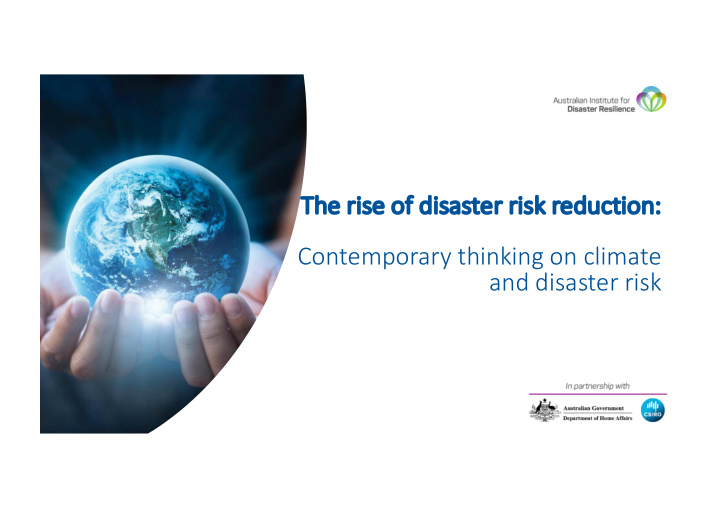



The ri rise of disaster r ri risk reduction: Th The r ris ise o of d f dis isaster r ris isk re reduction: Contemporary thinking on climate and disaster risk Co Contemporar ary th y thinki king o on cl climate e and disaster er risk
Curr rrent Context We are experiencing the effects of a changing climate today
Curr rrent Context Seeing beyond the present day John Blackburn: bit.ly/DisasterRiskVideos 3
Curr rrent Context Visualising the rate of global temperature change over time Our actions will decide which course we take We are here Industrial Revolution begins Paleoclimate timeline: Source: https://www.smithsonianmag.com/science-nature/paleoclimate-timeline/
National Disaster r Risk Reduction Framework rk A new agenda “In changing how we think about disasters and working together, we can take action to be better prepared and more resilient for what ever comes out way”
Ch Changin ging g how we e thin ink What makes us vulnerable when severe to catastrophic events impact what people and society value? • Severe to catastrophic events are inevitable We do not need to know where or when events will manifest in • order to be better prepared nationally • In most instances, disasters are not ‘natural’ We need to inquire ‘why’ and ‘how’ do naturally occurring events • lead to devastating suffering and loss. • Understanding disaster risk is more than understanding hazards • Vulnerability is the least understood dimension of disaster risk.
Understanding systemic ri risk A big picture view that we can all relate to. All levels. All sectors. All communities. In complex systems, cause and effect are often distant in time and space Source: Karlnorth.com
Stori ries of the lived experi rience Experiences of disaster and recovery Michael Jenkins & Mary and Paul Clark: bit.ly/DisasterRiskVideos 8
Responsibility is not equally shared Re Decisions and trade-offs create systemic vulnerability There are limits to the ability of individuals and • communities to reduce their vulnerability Some groups in society have disproportionate power to • increase or reduce vulnerability, while others are disproportionately vulnerable • Understanding the cycles and points where our individual and collective capacity to cope reach its limits, can provide clues for points of intervention.
Stori ries about systemic vulnerability Typical patterns that can apply to a range of places or contexts “Vulnerability sounds like truth and feels like courage... Vulnerability is not weakness. And that myth is profoundly dangerous. Vulnerability is the birthplace of innovation, creativity and change.” - Brene Brown
Va Values A big picture view that we can all relate to. All levels. All sectors. All communities. • People value things differently in stable times and in the face of disaster • All values cannot be satisfied at the same time and trade- offs are made People value the processes in society that keep them safe • and prospering
Navigating the journ rney ahead 2019 Global Assessment Report on Disaster Risk Reduction
Navigating the journ rney ahead What we’ve learned Systemic vulnerability needs to be addressed • Better decision making is key to preventing • and reducing disaster risk Equip decision makers with the right • knowledge A suite of options is needed to address • disaster risk Recognise the connections between disaster • risk reduction, climate adaptation and sustainable development
Foundations for r catalysing action Turning the page: reducing systemic climate and disaster risk
Th Thank you ou “The future is not pre-determined in any important sense. It is not an unknown land into which we totter unsteadily one day at a time, but an extension of the present that we shape by our decisions and our actions. The future is not somewhere we are going but something we are creating. We all have a role in shaping Australia's future ” Emeritus Professor Ian Lowe
Recommend
More recommend